First, I have to add another one of those things that remind us we don't live in the U.S.. The Cities of the Dead in Cairo are famed, huge tracts of land devoted to family mausoleums. Over time, the cities of the dead have also become the cities of the poor. Some of Cairo’s poorest live in the alleys and mausoleums, like this photo of a woman cooking inside one such with an elaborate sarcophagus next to her (I took this off the internet). Seeing the cities of the dead stretch out as you take the highway into Cairo is amazing—they seem to go on forever.
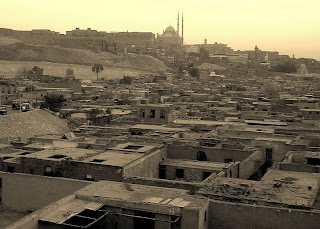 |
| one of the cities of the dead |
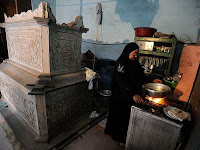 |
| Woman cooking in mausoleum |
 |
| Through the bus window, another half-finished building |
There is a flipside to the Cities of the Dead. A common feature of the Cairene cityscape are thousands of unfinished buildings, sometimes covering several square kilometers. Often, the first floor or two are occupied but the upper floors remain unfinished. We have heard several explanations for this phenomenon, but here is the executive summary: most Egyptians prefer that their investments be concrete (quite literally), and thus buy land and begin to build upon it. Sometimes families pool resources. These buildings, so we hear, function as the future homes for sons and daughters when they marry (the assumption is that everyone
will marry—no matter your sexual direction or personal preference, the heteronormative goal of marriage abides). We’ve heard that until the building is occupied, no taxes are due, so shells of buildings abound, awaiting their future occupants. Harris has named these the “cities of the unborn..”
 |
| Make your investment concrete |
The Eid Al Adha holiday began Thursday night the 3rd, celebrating the near-sacrifice of Ismail (in the Qu’ran) or Isaac (in the Hebrew Bible). We were happy to leave the city and avoid seeing the sheep sacrificed in honor of the feast. Though it’s illegal to conduct home butchering, evidently it is common, and some have told us the streets of Cairo can be quite bloody. Certainly there were abundant flocks of sheep lining the streets before we left. I suspect their numbers will be vastly decreased when we return on the 12th.
 |
| Blue Fin |
When Friday the 4
th rolled around, we hightailed it to the airport for a short flight from Cairo to Hurghada to join the
MV Blue Fin, a liveaboard dive boat whose itinerary this trip took us to the Brothers islands about an 8 hour steam south of Hurghada, then to Safaga, the port for Luxor. The Brothers, a pair of tiny islands in the middle of the Red Sea, boast sheer walls covered with hard and soft corals, and are famed for currents and shark sightings. The currents were entirely manageable, and we were delighted by the fishes.
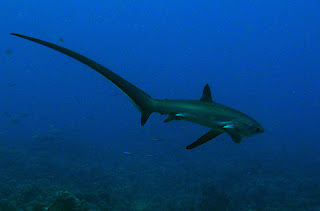 |
| Thresher shark |
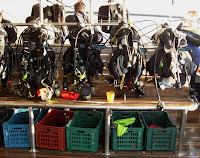 |
| Dive deck gear |
Our favorite was the magnificent thresher shark, a splendid animal whose body is about half tail; it swats schools of sardines with its tail, and gobbles up the stunned fish. Diving there meant 5:30AM calls since the government does not permit night diving, but those early dives were when we saw threshers. Their sinuous swimming motion and large eyes make them the most aesthetically pleasing sharks we have seen. The smaller of the two, Little Brother, sported a series of small piles of rocks along its shores, which Harris dubbed Egypt’s Lesser Pyramids.
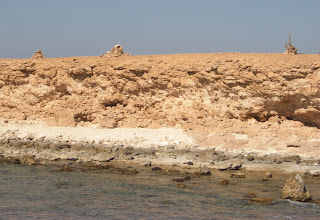 |
| Egypt's Lesser Pyramids |
Blue Fin was a remarkably nice liveaboard dive boat managed by a U.K. company. We booked a king suite and had more room in it than in any boat we’ve lived aboard, plus our suite came with its own plasma TV and mini-fridge. We watched trashy movies like “The A-Team” and “Dodge Ball” when we were not socializing with the other divers, largely from the U.K.. The waters there were not for the faint of heart: they were cold, with my computers reading 71 degrees F on some dives and 66 on the one night dive (and this is the average of the 6 computers we wear between us—that is seriously cold water). Both of us exhausted our supply of wetsuits, hooded vests, neoprene socks, and gloves, and envied the one diver on the boat who brought a drysuit. The food was healthy and plentiful, and we were only too happy to gobble it down to replace those precious lost calories from diving. (That’s my story and I’m sticking to it.)
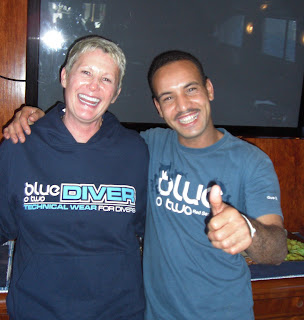 |
| Mel and Hamdi |
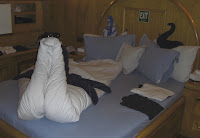 |
| Hamdi's art |
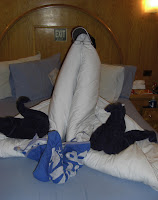 |
| My favorite linen sculpture |
One feature of the voyage kept us in stitches. Head steward Hamdi took perverse delight in not only policing up cabins between dives, but in our case, rearranging the duvet, towels, and pillows to create…well, sculptures from linens. One included a duvet transmuted into a swan, wearing my baseball cap and reading glasses; another, a birdlike duvet with a covey of towel fowl. We called it The Many Faces of Duvets. Hamdi’s wit provoked laughter after every dive no matter how chilled we were.
The Safaga and Hurghada dive sites were very different from the Brothers, reefs rather than sheer walls, with more chances to bimble around looking for creatures. I particularly enjoyed the shallower parts of the reefs when the sun sparkled on the stony and soft corals, bringing out the blues, greens, and purples of their colors while multi-colored fishes darted in and out. Total eye candy but we loved it. We did an afternoon and night dive on The Seven Pinnacles, a lovely site near Safaga.
BTW, the transits between Hurghada, the Brothers, Safaga, and back were impressively rough. Of course, Blue Fin is a dive boat, not a cruise ship, so eight foot seas at 12 knots tosses you like salad. We remembered our Bonine every day (“pleasant raspberry-flavored chewable!”) and were fine, but other divers forgot and spent time worshipping the porcelain god, no treat in a marine head. The waters around the Brothers were rough enough that one inflatable was shredded on the rocks and reef despite the best efforts of the driver. Admittedly, there were moments shaking with cold, dripping and salty, whipped by wind, and tossed by waves when we asked ourselves why we do this? The answer, of course, are creatures like thresher sharks. Also, on a good boat, the camaraderie and cheer of convivial shipmates creates its own good climate, even if we go our separate ways after disembarking.
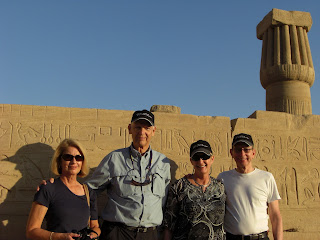 |
| Rita and Bill Bruce, me and Harris at Karnak |
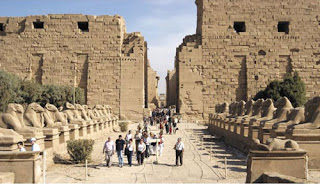 |
| Entry to Karnak with ram-headed sphinxes |
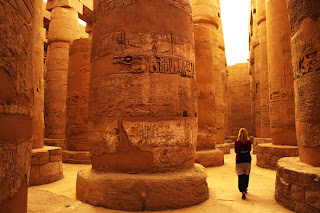 |
| and the columns are at least 6 stories high, too |
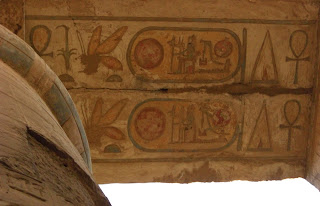 |
| Painted details of Karnak's ceiling |
After 5.5 dive days, Blue Fin returned to Hurghada, where we flew first to Cairo and then to Luxor for an overnight with my aunt and uncle, Rita and Bill Bruce. It was deluxe. Bill and Rita met us at the airport with a guide, driver, wrangler, and van, and after a lovely lunch at the Luxor Hilton (where we stayed), we set off to visit the temples of Karnak and Luxor—about as much as one can do in a short afternoon. Karnak (not to be confused with Johnny Carson’s Karnak the Magnificent, may the yak of happiness fly up your nose) was built over 1500 years, with one pharaoh adding to the next. The temple complex is enormous, about 100 acres, yet until the advent of tourism, only priests and pharaoh ever went beyond the outermost courtyard, lined with ram-headed sphinxes. The temple is not just about worship and keeping Amon happy, but about demonstrating pharonic power. Each sanctuary is more spectacular than the last, with the most breathtaking being the 134 columns erected under Ramses II (who ruled for 67 years). The columns themselves are either topped with capitals representing the open lotus flower, while the rest represented the papyrus plant. The scale has nothing to do with humans—it’s all about power and the deity—and I pulled a photo off the internet to give some idea of what it’s like inside the area with its many columns.
Luxor temple was not quite on the scale of Karnak, but fascinating for its layers of history. There were hieroglyphics for arguably the last pharaoh, Alexander the Great; a small area where early Christians worshipped, with bits of plaster remaining on walls under which were carved earlier pharonic glyphs. One wall of the temple was actually the back wall of a mosque built in the 13th century, when the temple was covered by sand and dirt, with only the tip of an obelisk peeping out. The sun was setting as we wandered through the temple, and the warm colors made it particularly beautiful.
After a sound and light show at Karnak, Rita, Bill, Harris and I went to a Nile-side restaurant for a delicious Egyptian meal. By the time we tumbled into bed around 10, I can safely say all of us were happy and very tired. Rita and Bill left to join their ship for a cruise up the Red Sea and through the Med, Harris and I went back to Cairo (quickly becoming Egyptair frequent fliers) and today was business as usual. As I taught today’s classes, sometimes I’d think of how 36 hours before, I was in the presence of ancient stones and displays of power. Talk about cognitive dissonance. This week is a normal one, teaching, dinner with friends, then next week, another AUC-sponsored trip to two Red Sea monasteries, Saint Anthony’s and Saint Paul’s. But we will get to sleep in a regular hotel and won’t be taking up anything more monastic than reverence in front of Coptic arts! Big hellos to all.


















